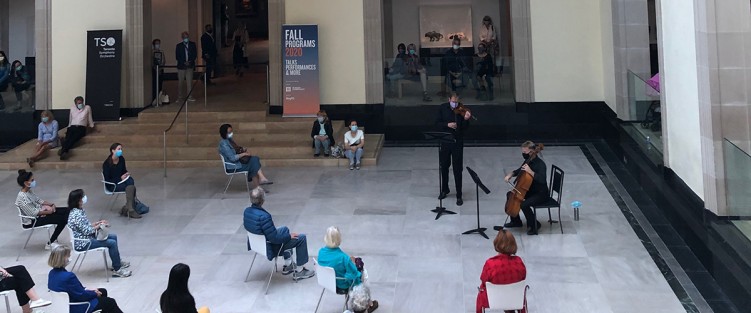 The Toronto Symphony Orchestra has mastered the now-ubiquitous virtual program, hosting Facebook Live recitals and “Watch Parties” of archived performance videos – check out #TSOatHome – while the doors of Roy Thomson Hall remain bolted shut. This September, however, the TSO announced several in-person concerts held in alternative venues, beginning with AGO Live: Hello From The Other Side, part of a series of relaxed afternoon shows hosted by the Art Gallery of Ontario (AGO) to bring live musicians into the gallery space.
The Toronto Symphony Orchestra has mastered the now-ubiquitous virtual program, hosting Facebook Live recitals and “Watch Parties” of archived performance videos – check out #TSOatHome – while the doors of Roy Thomson Hall remain bolted shut. This September, however, the TSO announced several in-person concerts held in alternative venues, beginning with AGO Live: Hello From The Other Side, part of a series of relaxed afternoon shows hosted by the Art Gallery of Ontario (AGO) to bring live musicians into the gallery space.
On September 25, museum-goers trickled into the AGO’s spacious Walker Court and carefully sat or stood in front of TSO concertmaster Jonathan Crow and principal cellist Joseph Johnson, who kicked off the season with a program of six short duets. The surprise repertoire was eclectic and fresh, the execution highly energetic. Though this was billed as an informal concert, the players – like two champion racehorses bursting out of the gates – channelled a startling intensity that made for a swift and exciting performance.
The masked duo opened with Mozart’s Sonata in C Major (K46d), transcribed from the original piano version, exchanging lightly teasing melodies with crisp and sparkling articulation. This cheerful dialogue was sustained in the Sonata for Violin and Cello in D Major by 18th-century Italian-born cellist Boccherini (arr. Paul Bazelaire), whose excellent second movement, Vivace, played like a bristling argument between old friends. After six months of listening to tinny audio recordings, it was sheer relief to hear Crow and Johnson’s warm, generous tones fill the furthest corners of the sterile white court.
Things took a moodier turn with four selections from Eight Pieces for Violin and Cello by Reinhold Glière (1875-1956), a Soviet composer known for his Romantic sensibility. The frenzied, bee-swarmed Étude was an impressive technical feat, but the wonderful final movement, Scherzo, a complex piece in triple metre, brought a sinister edge to the form’s playful precedents with unpredictable melodic pivots. Glière builds near-cinematic suspense with a rich vocabulary of dark sounds that Crow suggested were inspired by the Russian language itself; perhaps some lockdown angst helped the players electrify this beguiling composition.
Glière was thrown into relief by a hopeful composition entitled The Current (And Those Who Ride It), a 2017 work by violinist and University of Toronto alum Alice Hong. The piece began mysteriously, a tentative violin line skating softly over the cello, which murmured beneath like a quick-flowing brook; eventually the violin grew bright and earnest, both it and the cello striving to catch the melody.
The performance culminated in the exciting Passacaglia for Violin and Cello, reworked by Johan Halvorsen (1864-1935) using themes from Handel’s Suite no. 7 in G Minor for harpsichord. A firework of a piece, the players exchanged fierce dotted rhythms accented by spectacular dynamics and trills. We were sent off with the much gentler Aria from Bach’s Goldberg Variations, another work written for harpsichord whose pure, even tones formed a soothing denouement.
Though I couldn’t read their expressions, Crow and Johnson seemed to be having a blast, relishing the ability to perform after six months of living room practice. After a short break they ran through it all again, encouraging those who attended the first time to listen while exploring the European galleries nearby. What was lost in clarity was supplanted by other magical qualities – with some distance, the violin’s quickest notes began to flow together like tinkling wind chimes, and for a moment the museum became a well-stocked palace.
But trying to appreciate visual art and classical music at once is not as simple as it might seem. When listening to a piece like Glière’s Étude, already full of vivid imagery, it becomes difficult to focus on paintings with a strong narrative subject; the two works compete for attention and ultimately something is lost from both. On the other hand, music can add intrigue to a quieter painting whose meaning is less clear cut. In The Avon Gorge with Clifton and the Hotwells, for instance, a muted watercolour landscape by Francis Danby, the notes of Boccherini seemed to animate the tiny pointing figure in foreground, stirring up some tension in an otherwise sedate composition.
If this concert is anything to go by, the AGO Live series is set to be a thrilling one, and not just for its novelty. Without having to worry about ticket sales, the performers can select more daring repertoire, digging up offbeat and lesser-known duets. I would recommend any classical music lover take advantage of this perhaps rare opportunity to hear some of Canada’s best musicians up close (but not too close), while surrounded by one of the largest collections of visual art in Canada.
AGO Live: Hello From The Other Side, free with timed-entry museum admission, runs on Friday afternoons through January. See https://ago.ca/ago-live/hello-from-the-other-side for the complete schedule.
Jane Coombs is a writer based in Toronto. She recently graduated from Cambridge and the Courtauld Institute.


